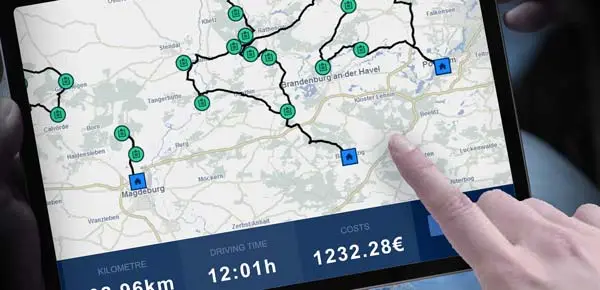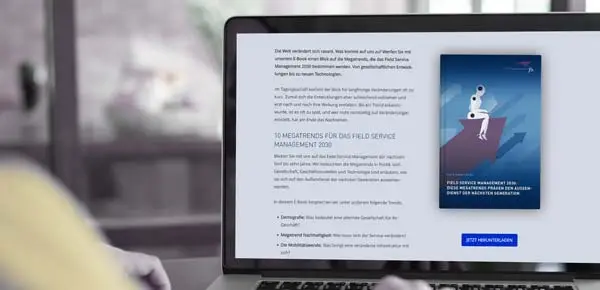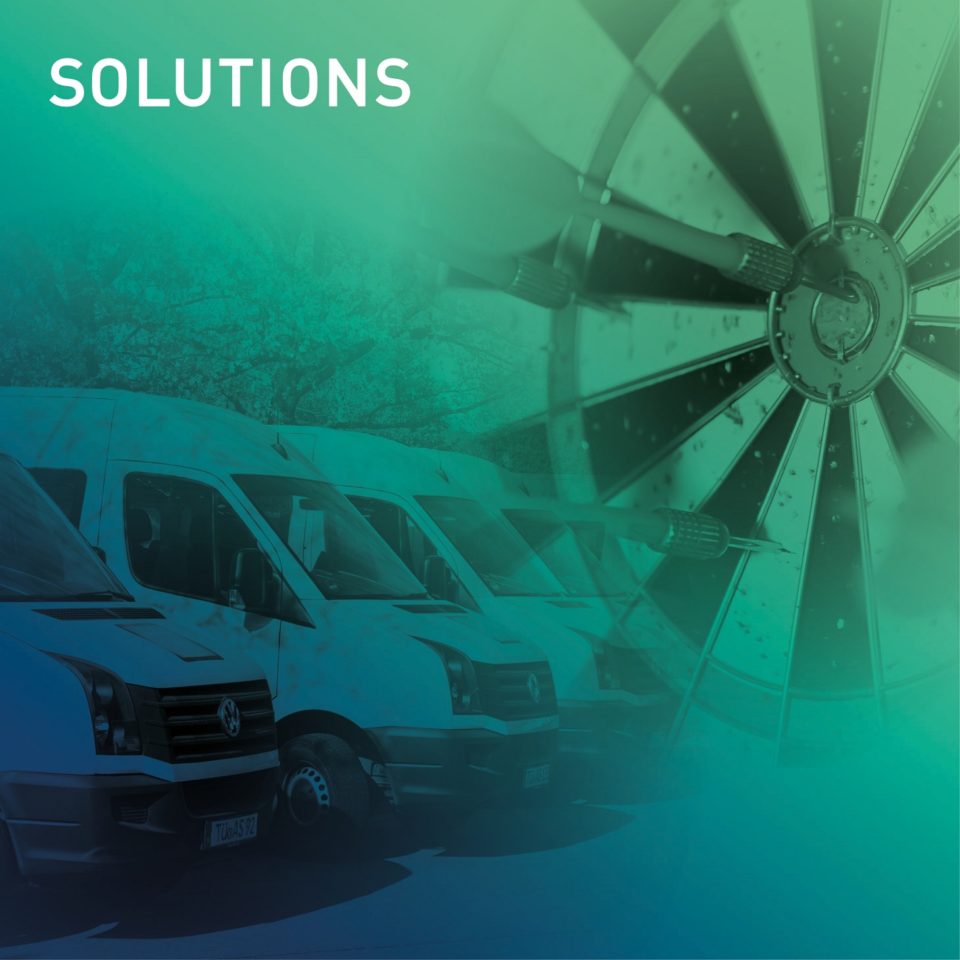
BLOG / SOLUTIONS · FIELD SERVICE MANAGEMENT SOFTWARE
IS NOW THE TIME FOR PROFESSIONAL FIELD SERVICE MANAGEMENT SOFTWARE?
29 November 2021 · Christoph Bertram
Many companies have employees in the field: service technicians, sales employees, appraisers, certifiers, delivery drivers - summarised under the umbrella of field service. The scheduling and dispatch of these employees can quickly become highly complex. Everyday office tools and the standard functions of an ERP or CRM system are then no longer sufficient to guarantee the optimal planning of orders, routes, working hours and costs. A specialist solution for scheduling and route planning is required. Here, we hold a mirror to your current operations and give you a steer towards questioning if there's a better outcome.
Also read: 10 Field Service Planning myths that cost your business
WHAT TYPES OF COMPANIES USE PROFESSIONAL FIELD SERVICE MANAGEMENT SOFTWARE?
In principle, professional software for scheduling and route planning is an option for both medium-sized and large companies in a wide variety of industries. Be it in trade, in technical service, in facilities management, or in expert testing and certifications. How you use it depends on the individual needs of your business. The software should be able to accomodate your growing needs.When is the introduction of a special solution worthwhile? Below we go highlight the signs that it is time for you to discuss your move into professional field service management software.
POINT 1
YOUR FIELD EMPLOYEES ALWAYS DO OVERTIME
Maybe it's because you have too few staff for too many jobs. But overtime is more often a sign of suboptimal planning. Professional software knows the actual average processing times for each type of order and keeps an eye on the working hours of the employees. It optimises the routes and eliminates idle times, so that at the end of the day all orders were completed on time.POINT 2
YOUR SCHEDULING TEAM OVERLOADED
Manual field scheduling is time-consuming. You cannot react quickly to sudden changes in the plan. That leads to stress and the potential loss of priceless 'insider' knowledge. A professional field service management software cleans your schedulers' workflows and accelerates the processes. With FLS VISITOUR you can opt for semi-automatic or fully automatic appointment and tour planning using the software.POINT 3
YOU HAVE MORE THAN 20 RESOURCES IN USE
As a rule of thumb: A professional field service management software is worthwhile from around 20 field service resources (employees or vehicles). Before that, the investment rarely pays off compared to manual scheduling. From 20 resources onwards, however, the gain in efficiency is so high that the investment is worthwhile for you and your company benefits in the long term.POINT 4
YOUR WORKS ORDERS ARE DYNAMIC
The point follows on from the previous one. If your order process is fairly static - for example aconstruction company whose employees are often on the same construction site for days or weeks - the optimisation potential of the software is rather low (but never insignificant). However, if your employees must attend several jobs in different locations every day (and there are ad-hoc jobs to meet SLAs) then specialist software is the best way to master this complexity and dynamism.REACTIVE WORKS ARE HURTING YOUR FIELD SERVICE
An emergency order, illness-related breakdowns, a vehicle breakdown - day-to-day business has many surprises in store. How quickly does your field service react to the unplanned? If the answer is always 'not fast enough,' you should require a solution. Specialist software is built on the most up-to-date, self-learning algorithms for real-time planning . This makes it possible to react automatically to such events and to adapt directly with calculations in the background.POINT 6
CUSTOMER COMPLAINTS INCLUDE WIDE APPOINTMENT WINDOWS OR FAILURE TO FIRST-TIME-FIX
A window betwen 8a.m. and 6 p.m.' - the classic, old-fashioned answer for customers. It's possible to modernise and offer all customers an individually selectable appointment window, that is smaller and and more appropriate. Imagine automatically offering choices between 8-10 a.m., 12 p.m.-2 p.m. and 3 p.m.-5 p.m. A professional field service management software pulls these cost-calculated windows from a server, then via customer portal offers the opportunity to select any desired changes. The adherence to deadlines rises, all thanks to optimised scheduling.POINT 7
YOU MUST INCREASE YOUR FIRST-TIME-FIX RATE
If you work in technical field service, the first-time fix rate (error correction rate on the first customer visit) is an important KPI. This measure of success and profitability can be improved with professional field service management software. The system optimally assigns employees with their skills and certifications versus availability, as well as equipment, vehicles, and spare parts to the works orders and thus ensures a smooth process.Also read: How apartment provider Vivawest solved its first-time-fix rate
POINT 8
DIFFERENT JOBS REQUIRE DIFFERENT SKILLS
Your jobs require a multitude of different skills and not every employee can work on every job. Supportive field service software takes such restrictions into account. It automatically assigns employee qualifications or experience to the relevant jobs. There is no room for a mismatch. It's critical to select a system that can recognise when several employees are required for a particular assignment, with no knock-on effects.POINT 9
YOU ARE TRAPPED IN PAPERWORK
Why are is your scheduling and field dispatch team the only department still relying on paper and wall charts? With a digital field solution, you can finally put a stop to mountains of paper. As well as going green, your employees do not have to walk or drive by the head office or warehouse for their order slips and daily instructions. With an integrated app , you always have all the customer data relevant to your order with you. Last but not least, professional field service management software is a tool for digitising your processes, documentation, and audit trails.POINT 10
YOU NEED TO SAVE MILES/KILOMETERS AND CO2
Do you want to make your company more sustainable? Would you like to save energy and CO2? With an optimised route planning, modern software builds routes and tours with these goals. FLS customer SECO Kältetechnik GmbH for example, was able to achieve a mileage saving of 52 percent, just through the deployment and optimised use of exisiting resources. This corresponds to a CO2 reduction of 900,000 kg.POINT 11
INFLATION IS EATING INTO YOUR PROFIT MARGIN
High cost pressures are appearing across most industries, and their suppliers. Perhaps that is a major reason to consider increasing the efficiency of your service. You can do this by optimising your schedule and efficient route planning. The appropriate software solution ensures cost transparency and recognises optimisation potential. It lowers travel costs and increases the productivity of the field service through automation and optimised order planning. The investment in a special solution will soon pay for itself.POINT 12
YOU WANT TO PROCESS MORE ORDERS
Professional field service management software is not only a tool for cost optimisation, it also enables order processing to be maximised. For example, FLS VISITOUR recognises synergy effects: if a service technician is on site for a repair and the customer is also due for regular maintenance, the system notifies the dispatcher or the employee. The field resource can take care of the maintenance at the same time.PROFESSIONAL FIELD SERVICE MANAGEMENT SOFTWARE: AN EASY INTEGRATION
You may be well positioned in some areas, and recognise other gaps in your field operations. Professional field service management software truly ensures you're gaining the most from your existing resources, and much more. FLS VISITOUR can be used both as a stand-alone solution and linked to your ERP/CRM system. You will still realise the benefits of a best-of-breed solution without moving your entire IT stack.To gain an understanding of tools to optimise the field experience and manage efficiency for your workforce and customers book a short discussion or contact us at info@fastleansmart.com.
Read more:
3 things to know about Geocoding and Mobile Workforce Management
What modern software can do for tour optimisation
Stop planning Field Service Appointments with Outlook
Route Planning with Google Maps? 5 reasons this is impossible

CHRISTOPH BERTRAM
Marketing
+44(0) 1183 800189
Send email
Christoph Bertram has been writing within the workforce software solutions sector for over 10 years. As an editor in the HR sector, he dealt with cloud technologies early on, later as an online editor and content manager with digitalisation in the skilled trades. He has been writing about route planning and field service management for FLS and the Solvares Group since 2021.





